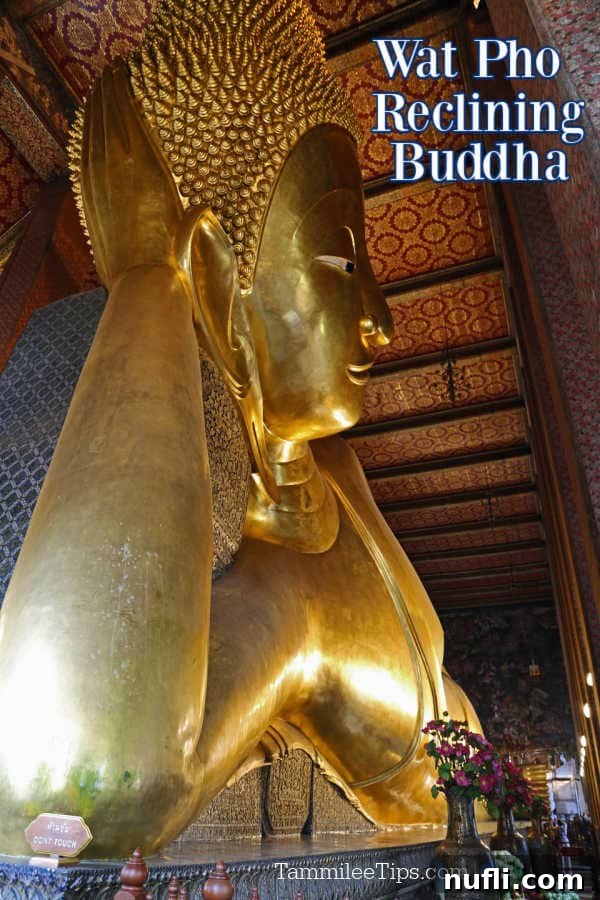Visiting Wat Pho, the revered Temple of the Reclining Buddha in Bangkok, Thailand, has long been a cherished travel goal for many, including myself. This iconic landmark consistently tops lists of must-see attractions, and for good reason. During my recent adventure through the captivating landscapes of Thailand, I dedicated a memorable afternoon to immersing myself in the grandeur and spiritual serenity of the entire Wat Pho complex. From the moment you step onto its sacred grounds, you are transported into a world of profound beauty, intricate artistry, and deep-rooted history, promising an unforgettable cultural experience in the heart of Thailand’s vibrant capital.
Nothing truly prepares you for the sheer scale and breathtaking majesty of the Reclining Buddha statue itself. I had certainly anticipated it being large, having seen countless images online, but the reality far surpassed any expectation. The colossal golden figure, stretching an incredible 46 meters (approximately 150 feet) in length and rising 15 meters (around 50 feet) in height, dominates the temple hall, commanding awe and reverence from every visitor. Its immense size is only matched by the intricate details and the serene expression it conveys, depicting the Buddha in the posture of Parinirvana, or entry into Nirvana. It’s a moment that leaves you breathless, truly a “WOW!” experience that encapsulates the spiritual and artistic prowess of Thai craftsmanship.
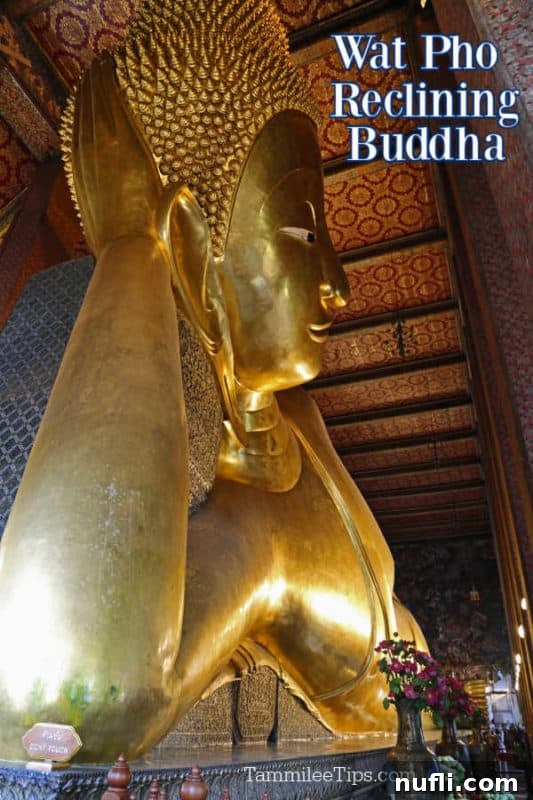
Exploring Wat Pho: Home of the Magnificent Reclining Buddha in Bangkok, Thailand
Wat Pho, officially known as Wat Phra Chetuphon Wimon Mangkhalaram Rajwaramahawihan, is more than just a temple; it’s a sprawling complex of spiritual significance, historical richness, and artistic splendor. While the magnificent Reclining Buddha is undoubtedly its crown jewel, the entire compound offers a labyrinth of beautifully adorned pagodas, serene courtyards, and ancient murals that tell stories of Buddhist cosmology and Thai culture. To truly appreciate this sacred site, it’s essential to understand a few key aspects before your visit to ensure a respectful and fulfilling experience.
Essential Tips for Your Wat Pho Visit and Temple Etiquette
Before you even step foot inside the main temple housing the Reclining Buddha, there are a few important customs and practical considerations to keep in mind:
- Respectful Dress Code: As with all Buddhist temples in Thailand, a modest dress code is strictly enforced. Visitors are required to cover their shoulders and knees. This means no tank tops, spaghetti straps, short shorts, or skirts above the knee. While some temples offer sarongs for rent at the entrance, it’s always best to arrive prepared with appropriate attire to avoid any delays or inconvenience. Showing respect through your dress is a fundamental part of visiting sacred sites in Thailand.
- Shoe Removal Protocol: Upon entering the main viharn (assembly hall) of the Reclining Buddha, you will be required to remove your shoes. This is a common practice in Thai temples as a profound sign of respect. Don’t worry about where to place them; attendants typically provide a reusable plastic bag for you to carry your footwear with you. You’ll carry them through the temple and retrieve them at the exit point, preventing any mix-ups or lost shoes, and ensuring the cleanliness of the sacred space.

Another crucial point to remember is to remain vigilant and aware of your surroundings, especially your personal belongings. Wat Pho is an incredibly popular tourist destination, attracting thousands of visitors daily from all corners of the globe. Due to the high volume of foot traffic, particularly in crowded areas around the main statue, there are prominent signs warning visitors about pickpockets. It’s advisable to keep your valuables secure, carry your bag in front of you, and avoid displaying large amounts of cash or expensive electronics overtly. A little caution goes a long way in ensuring a smooth and worry-free visit, allowing you to focus on the beauty around you.
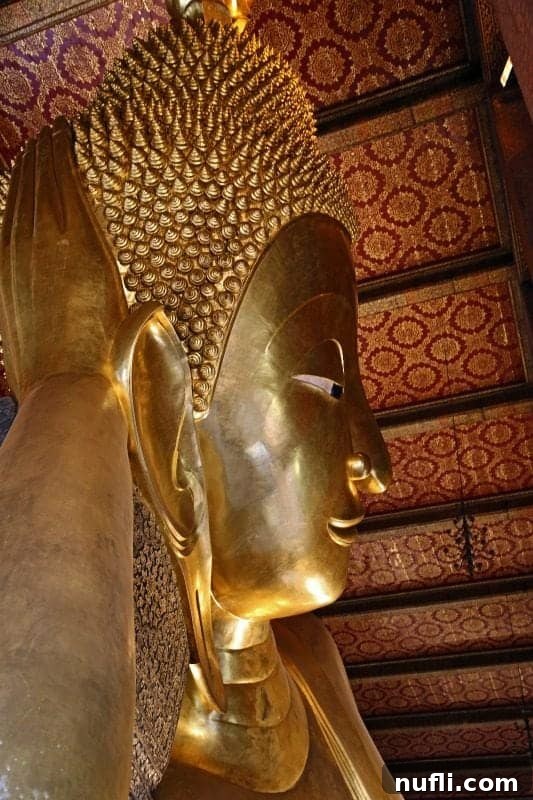
Experiencing the Grandeur of the Reclining Buddha
Upon entering the Reclining Buddha temple, you typically begin your walk near the Buddha’s head. The interior is thoughtfully designed for a one-way flow, guiding visitors along the immense statue towards the exit situated at its feet. This systematic approach helps manage the significant crowds, creating a more orderly and less chaotic viewing experience for everyone. As you slowly walk alongside the Buddha, take your time to absorb its grandeur and the intricate details that adorn it. This journey offers ideal opportunities to capture stunning photographs from various angles, but be prepared to pause and wait a few moments in certain sections to get the perfect shot without too many people in the frame. Patience, coupled with respect for other visitors, is truly key here.
The last thing you want to do is attempt to “swim upstream” against the steady current of other visitors. Not only is it disrespectful and disruptive to the spiritual ambiance, but it can also be quite challenging and frustrating in a crowded environment. Instead, embrace the journey, move with the flow, and allow yourself to be carried along by the collective admiration for this sacred masterpiece. The perspective changes dramatically as you walk from head to toe, revealing different facets of the Buddha’s posture and the rich surrounding artwork, enhancing your appreciation of its artistry and spiritual significance.
One of the most captivating aspects of the Reclining Buddha, beyond its immense size and golden sheen, is the incredible detail found on its feet. Each foot is meticulously inlaid with mother-of-pearl, depicting 108 auspicious characteristics of the Buddha, a highly significant number in Buddhist iconography representing the universal actions and symbols of the Lord Buddha. These intricate designs are not merely decorative; they tell stories and convey deep spiritual meaning, symbolizing universal prosperity and the various forms of the Buddha. Observing these patterns up close offers a fascinating insight into Buddhist beliefs and ancient artistry. Further along the statue, specifically on the side opposite the feet, you’ll discover a long row of 108 bronze bowls. Visitors can purchase a small cup of coins to drop into each bowl, a tradition believed to bring good fortune, make merit, and grant wishes. The gentle, rhythmic tinkling sound of coins dropping creates a meditative and unique soundtrack within the temple hall.
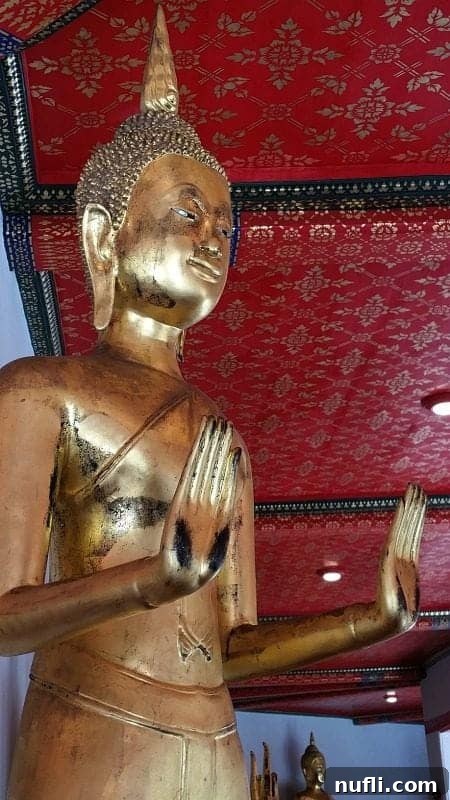

Beyond the Reclining Buddha: Exploring the Wat Pho Complex
While the Reclining Buddha is undoubtedly the star attraction, the Wat Pho complex, often referred to as the Temple of the Reclining Buddha, is a vast and enchanting ensemble of religious structures, vibrant gardens, and architectural wonders that demand thorough exploration. It truly deserves ample time; I highly recommend allocating at least a few hours, if not a full morning or afternoon, to fully immerse yourself in its diverse offerings. Rushing through would undoubtedly mean missing out on countless hidden gems and the tranquil atmosphere that pervades its many corners.
The complex is home to an astonishing collection of over 1000 Buddha images, including several exquisite gold Buddhas housed in various satellite temples and ordination halls scattered throughout the grounds. You’ll encounter stunning Phra Chedi (stupas), notably the four grand ones dedicated to the first four Chakri kings, each adorned with exquisite glazed ceramic tiles that shimmer brilliantly in the sunlight. These towering structures, often decorated with vibrant floral patterns and intricate mythological figures, are architectural marvels in their own right. As you wander through the courtyards, you’ll discover ornate pavilions, larger-than-life guardian statues depicting Chinese influences, and meticulously maintained gardens that offer tranquil retreats from the bustling energy of the city outside. Every corner holds a new detail, from detailed murals depicting scenes from the Ramakien (Thai national epic) to intricate carvings and statues that showcase the pinnacle of Thai artistry.
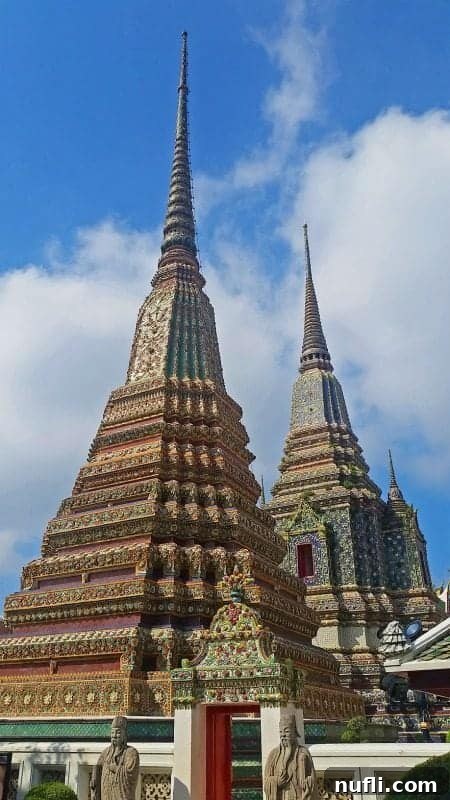
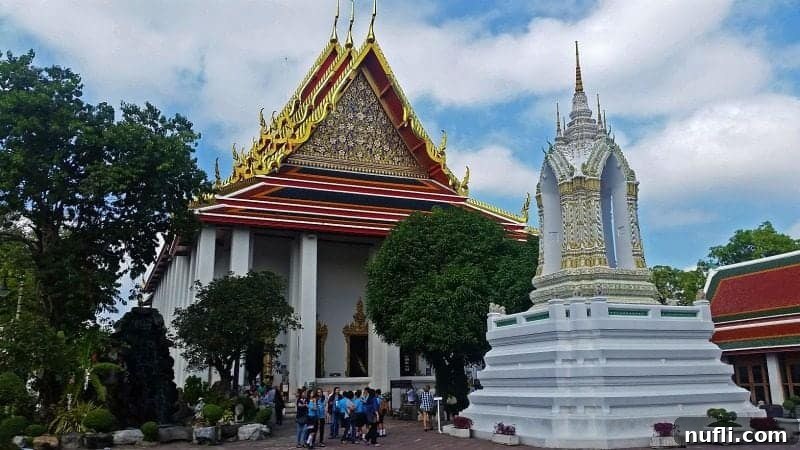
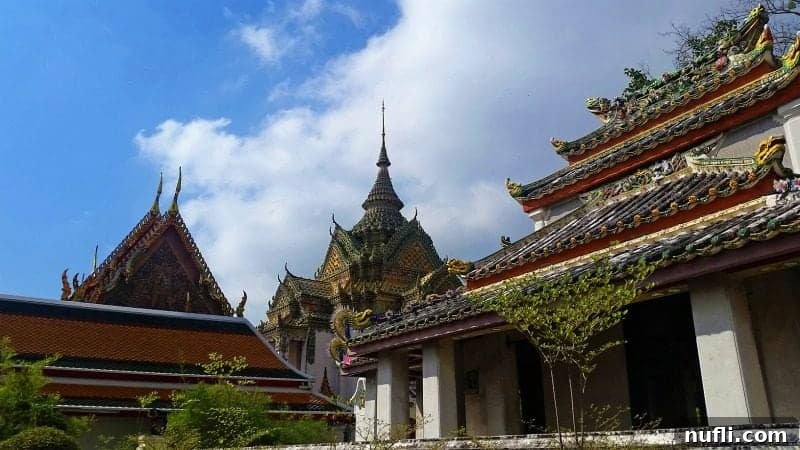
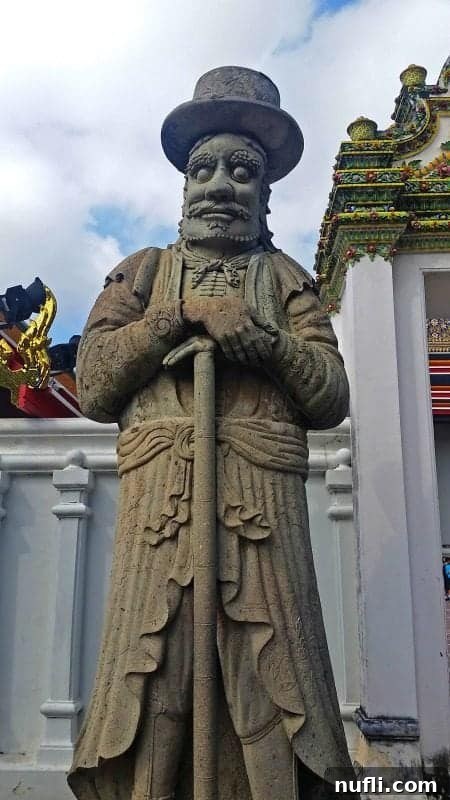
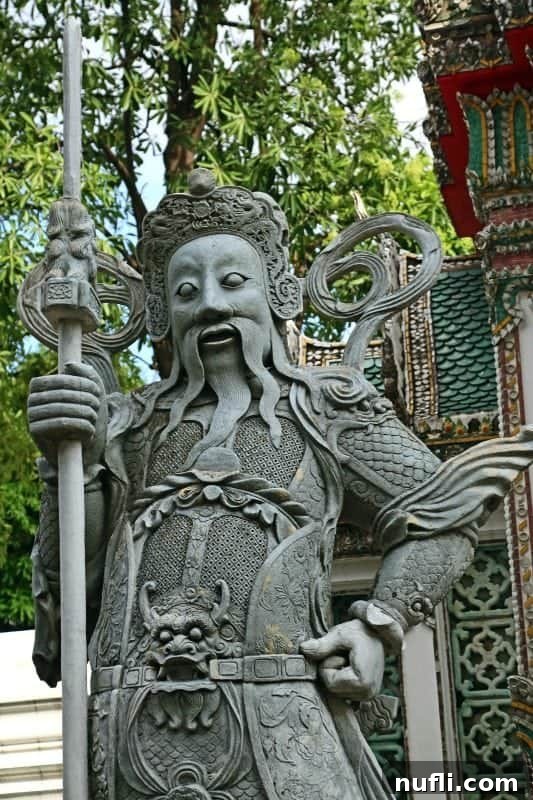
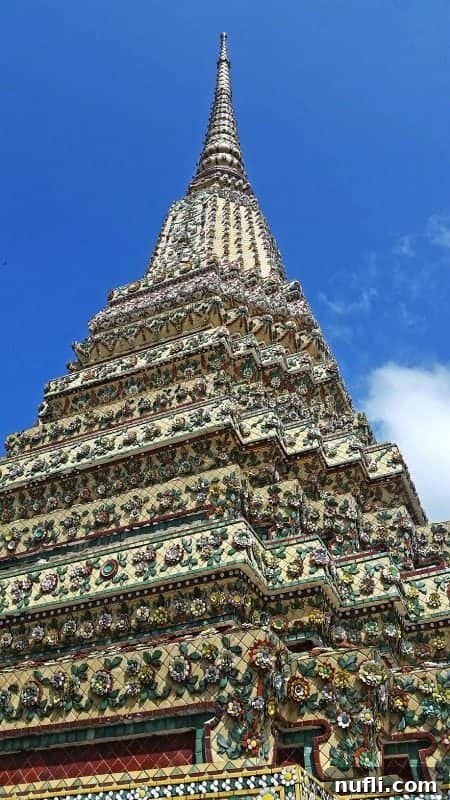
The Rich History of Wat Pho: Bangkok’s Oldest and Largest Temple
Wat Pho holds the esteemed title of being Bangkok’s oldest and largest temple. Its history is deeply intertwined with the founding of the Chakri Dynasty and the establishment of Bangkok as the capital. The temple, initially a much smaller monastery existing even before Bangkok was named the capital, underwent extensive rebuilding and expansion by King Rama I in the 1780s, shortly after he moved the capital from Thonburi to its current location. He painstakingly collected and installed Buddha images from abandoned temples across Thailand, many of which can still be seen today within the complex. This immense undertaking transformed the site into a grand royal temple, becoming a repository of Buddhist art and knowledge.
It was King Rama III, however, who spearheaded the construction of the magnificent Chapel of the Reclining Buddha, specifically to house the colossal statue, which was completed in 1832. Under his reign, Wat Pho also became a pivotal center of public education, effectively acting as Thailand’s first “open university.” Knowledge spanning history, literature, astrology, and traditional medicine was meticulously inscribed on stone slabs and statues throughout the temple grounds, making it accessible to the common people. This dedication to education and the preservation of ancient wisdom is a hallmark of Wat Pho’s enduring legacy, making it a living museum of Thai intellect and culture.
Birthplace of Traditional Thai Massage: A Unique Cultural Experience
One fascinating aspect of Wat Pho that many visitors might not immediately discover is its profound connection to traditional Thai medicine and, specifically, the art of traditional Thai massage. The temple houses a renowned Institute of Massage, making it widely considered the birthplace and leading center for authentic traditional Thai massage (Nuad Thai). Within the temple grounds, particularly in the medicine pavilion, you can observe ancient stone plaques that illustrate intricate massage points on painted human figures. These diagrams served as vital educational tools centuries ago, preserving the knowledge and techniques of this ancient healing art, which has since been recognized by UNESCO as intangible cultural heritage.
For those seeking a truly immersive cultural experience, visiting the massage school and indulging in a traditional Thai massage is an absolute must-do. It’s an experience that extends far beyond mere relaxation, offering a therapeutic journey deeply rooted in centuries of practice and spiritual understanding. The highly skilled practitioners here uphold the traditional techniques passed down through generations, providing an authentic and invigorating session that will undoubtedly be a highlight of your Bangkok trip. It’s more than just a massage; it’s a living piece of Thai heritage, offering both physical rejuvenation and a deeper connection to local traditions.
Planning Your Bangkok Exploration: Nearby Attractions and Combined Itineraries
Wat Pho’s central location makes it an ideal starting point or a natural continuation for exploring some of Bangkok’s other major historical and cultural landmarks. It is situated directly adjacent to the illustrious Grand Palace and Wat Phra Kaew (Temple of the Emerald Buddha), a complex that houses the sacred Emerald Buddha, making it incredibly convenient to visit these two world-famous sites together. Furthermore, Wat Pho is just a short, scenic ferry ride across the Chao Phraya River from the stunning Wat Arun (Temple of Dawn), known for its magnificent Khmer-style spire. Combining a visit to these sites in one day is highly recommended to maximize your time and experience the historical and spiritual heart of Bangkok efficiently.
If you are planning your itinerary for Bangkok, be sure to check out our detailed guide on visiting the Grand Palace in Bangkok for ideas and tips to navigate this majestic royal residence and spiritual complex seamlessly.
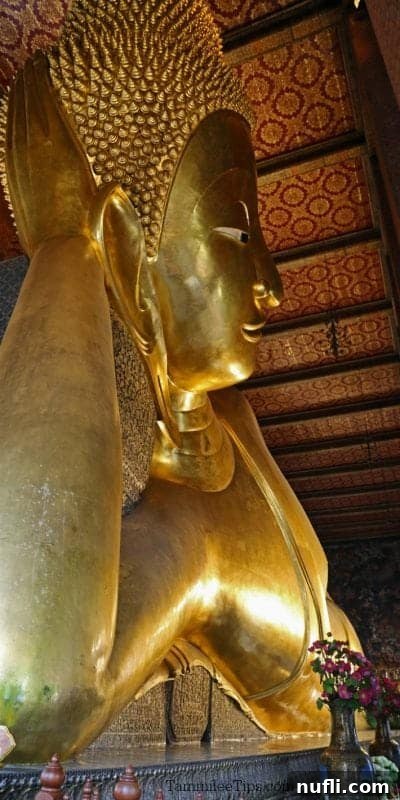
Final Thoughts on a Wat Pho Pilgrimage
A visit to Wat Pho is much more than just seeing a giant statue; it’s an immersive journey into the spiritual, historical, and cultural soul of Thailand. The sheer majesty of the Reclining Buddha, the intricate beauty of the surrounding chedis and pavilions, the echoes of ancient education, and the living tradition of Thai massage all combine to create an experience that is both awe-inspiring and deeply enriching. It stands as a vibrant testament to Thailand’s enduring Buddhist heritage and its welcoming spirit, inviting travelers to connect with its profound sense of peace and history. Make sure this incredible temple complex is at the very top of your Bangkok itinerary, allowing ample time to truly absorb its multifaceted wonders.
Additional Thailand Travel Resources
To further enhance your Thailand adventure and explore more of this incredible country, delve into these related articles:
- Ko Kret Market: Discover a charming island market accessible by boat from Bangkok, offering a glimpse into local life and handicrafts.
- Wat Arun in Bangkok: A comprehensive guide to the stunning Temple of Dawn, easily combined with a visit to Wat Pho.
- Boat Tour on the Chao Phraya River in Bangkok: Experience the city from its iconic waterway, exploring its hidden canals and vibrant river life.
- W Koh Samui Hotel Review: Insights into a luxurious island retreat for those seeking a tropical escape.
- Thai Dam Cultural Village in Northern Thailand: Explore authentic local culture and traditions in a lesser-known region.
- Afternoon Tea at the St. Regis Bangkok: A touch of elegance and indulgence in the bustling capital city.
- Phi Ta Khon Museum in Northern Thailand: Delve into the unique and vibrant ghost festival traditions of Loei province.
- Hello Kitty Hotel in Thailand: A quirky and fun accommodation option for themed travel enthusiasts.
- Chiang Khan in Northern Thailand: Discover a charming blend of tradition and modernity along the Mekong River.
